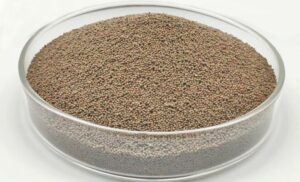Ceramic sand is a man-made, spherical or nearly spherical abrasive with high hardness and durability. It is made from ceramic materials such as aluminum oxide (Al₂O₃) sintered at high temperatures. These properties make it an ideal choice for efficient, high-quality, and environmentally friendly glass sandblasting.
The following is a complete analysis of the applications of ceramic sand in glass sandblasting:
I. Core Advantages of Ceramic Sand in Glass Sandblasting
Compared to traditional abrasives (such as quartz sand and brown corundum), ceramic sand offers significant advantages in glass processing:
Extreme Durability: Ceramic sand has a Mohs hardness of 7-8, second only to diamond and silicon carbide. It is resistant to breakage and can be recycled dozens or even hundreds of times, significantly reducing consumable costs.
Consistent Sandblasting Results: Due to its spherical or nearly spherical shape and high hardness, ceramic sand maintains its particle shape and size over repeated use, ensuring a uniform and consistent texture on the finished glass surface and avoiding surface contamination and uneven results caused by abrasive powdering.
High Processing Efficiency: High hardness, high kinetic energy, and strong cutting force enable faster blasting results, improving production efficiency.
Low Dust, More Environmentally Friendly: Its non-abrasive nature ensures minimal dust generation during sandblasting, improving the work environment, reducing health hazards to operators, and reducing the burden on air filtration systems.
Low Breakage Rate, Minimized Equipment Wear: High particle integrity causes significantly less wear and tear on sandblasting equipment (such as the spray gun, nozzle, hose, and recovery system) than irregular, brittle abrasives, extending equipment life and reducing maintenance costs.
Suitable for Precise and Intricate Patterns: Its uniform particle size distribution is ideal for blasting fine patterns, resulting in sharp lines and high detail.
II. Application Process and Key Technical Parameters
The process for applying ceramic sand to glass sandblasting is similar to traditional sandblasting, but certain parameters must be considered to maximize its performance.
Basic Process:
Pattern Creation: Based on the design, a durable sandblasting protective film (such as PVC or rubber film) is applied to the glass surface.
Engraving: Use a burr to precisely carve and peel off the protective film on the area to be sandblasted, exposing the glass.
Sandblasting Preparation:
Equipment Inspection: Ensure the sandblaster (usually a pressurized sandblaster), air source, spray gun, and nozzle are in good condition.
Abrasive Filling: Load the sandblaster’s abrasive chamber with the selected ceramic sand.
Sandblasting Operation:
The operator, using a handheld spray gun or automated sandblasting equipment, applies a uniform spray to the exposed glass area at a constant air pressure and distance.
The speed and repetition rate of the sandblasting determine the depth and haziness of the sandblasting.
Cleaning and Inspection:
After sandblasting, turn off the equipment and remove the glass.
Remove the protective film and clean any remaining fine dust from the glass surface with clean water or compressed air.
Inspect the sandblasting for uniformity and compliance with design requirements.
Key Technical Parameters:
Grit Size: This is the most critical factor, directly determining the final result.
Coarse grit (e.g., 60# – 120#): Used for rapid material removal, creating a deep, rough frosted effect with a strong texture. Commonly used for large decorations or areas requiring a strong hazy effect.
Medium grit (e.g., 120# – 200#): The most commonly used range, producing a standard, uniform, translucent frosted effect with a delicate feel. Suitable for most doors, windows, partitions, furniture, and artistic glass.
Fine grit (e.g., 200# and above): Used for a very fine, frosted, slightly hazy effect (similar to an acid etching effect), retaining the glass’s transparency while scattering light. Suitable for high-end decoration, precise patterns, and protective sandblasting.
Air Pressure: Typically ranges from 0.4 to 0.7 MPa. Higher air pressure increases cutting force and efficiency, but may also cause particles to embed into the glass or blur the edges of the pattern. Adjust the pressure based on the glass thickness and desired effect.
Gun Distance and Angle: Typically, maintain a distance of 15-30 cm from the glass surface and spray vertically at an angle of 70-90 degrees to ensure uniform results.
Sandblasting Media Concentration: Ensure the sandblaster’s mixing valve is properly adjusted to ensure a sufficient concentration of ceramic sand in the airflow.
III. Main Applications
Ceramic sandblasting glass is widely used in:
Architectural Decoration: Office partitions, hotel doors and windows, bathroom doors and windows, screens, curtain walls, etc., ensuring both privacy and natural light.
Household Furniture: Glass furniture (such as coffee tables and cabinet doors), lamps, photo frames, decorative paintings, etc.
Art Glass: Create intricate patterns, text, logos, etc. for gifts, souvenirs, and storefront decoration.
Industrial Glass: Anti-glare treatment for instrument panels and covers.
IV. Considerations
Cost Considerations: The initial purchase cost of ceramic sand is higher than that of traditional abrasives (such as corundum and glass beads), but its extremely long lifespan makes the overall cost of use very low.
Equipment Compatibility: Compatible with most reusable pressurized sandblasting equipment. However, for some small suction sandblasters, parameters may need to be adjusted to ensure efficient aspiration of the ceramic sand.
Moisture-Proof: Although ceramic sand is chemically stable, it should be stored in a dry environment to prevent clumping.

